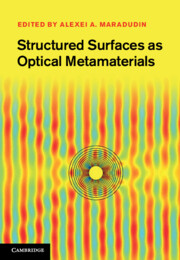7 results
Frontmatter
-
- Book:
- Structured Surfaces as Optical Metamaterials
- Published online:
- 01 June 2011
- Print publication:
- 21 April 2011, pp i-iv
-
- Chapter
- Export citation
Index
-
- Book:
- Structured Surfaces as Optical Metamaterials
- Published online:
- 01 June 2011
- Print publication:
- 21 April 2011, pp 427-436
-
- Chapter
- Export citation
List of contributors
-
- Book:
- Structured Surfaces as Optical Metamaterials
- Published online:
- 01 June 2011
- Print publication:
- 21 April 2011, pp xiii-xvi
-
- Chapter
- Export citation

Structured Surfaces as Optical Metamaterials
-
- Published online:
- 01 June 2011
- Print publication:
- 21 April 2011
Plate section
-
- Book:
- Structured Surfaces as Optical Metamaterials
- Published online:
- 01 June 2011
- Print publication:
- 21 April 2011, pp -
-
- Chapter
- Export citation
Contents
-
- Book:
- Structured Surfaces as Optical Metamaterials
- Published online:
- 01 June 2011
- Print publication:
- 21 April 2011, pp v-xii
-
- Chapter
- Export citation
Preface
-
-
- Book:
- Structured Surfaces as Optical Metamaterials
- Published online:
- 01 June 2011
- Print publication:
- 21 April 2011, pp xvii-xxii
-
- Chapter
- Export citation



